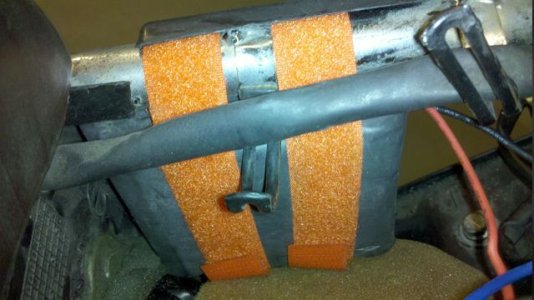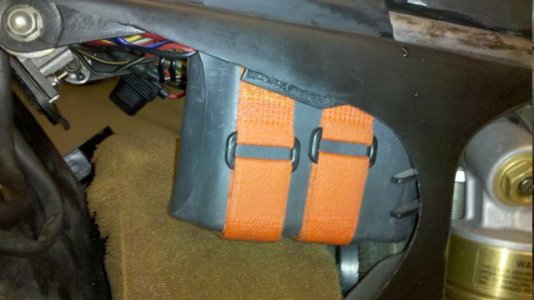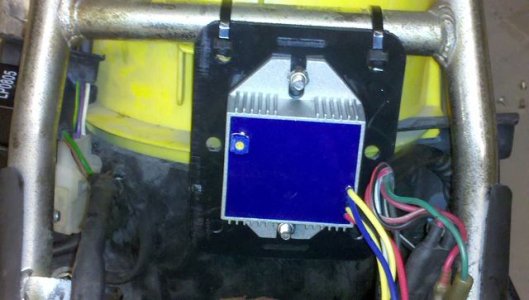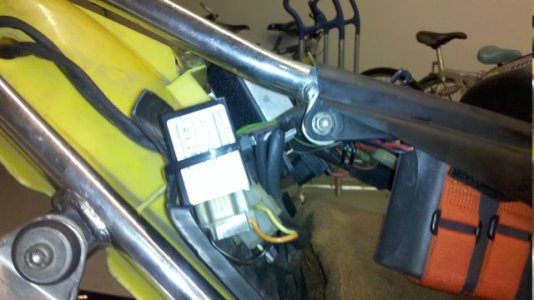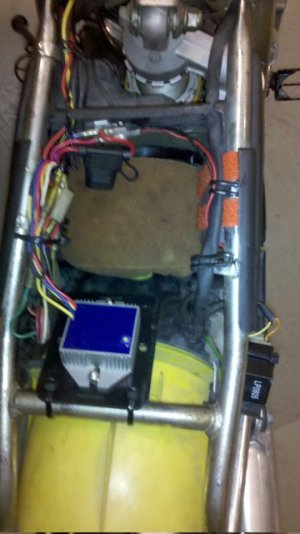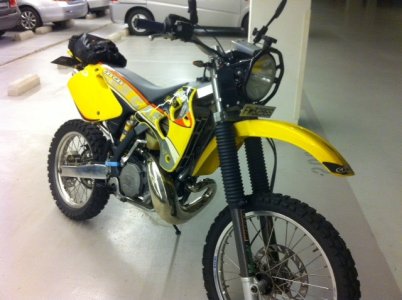Hi all - first post
Just bought a zero mile/hour 2000 EC200, had it a couple of months and have got fed up with dim lights and indicators that do not function with the lights on. So did the DC conversion without floating the ground.
Parts used
Trail Tech regulator/rectifier
Trail Tech battery
Part plate of a Trail Tech battery bag
Velcro anchor straps - two
Car flasher relay
Bullet connects
Spade connector
Wire, red and black
Cable ties
Heat shrink
Here is what I did - aim was no holes drilled and completely reversible
Battery install - lot of head scratching for location, but decided on right hand side of air filter box, was attached using two velcro anchor straps. See images Battery 1 & 2.
Install voltage regulator rectifier
Installed on rear/upper bar in air filter bay, this was mounted on the plastic packing plate which came with the battery bag (bag not used), this plate was cable tied to bar. See Rectifier Regulator mount.
Next located the AC regulator and removed
Located earth for lights/indicators/horn etc - this was located above AC regulator; remove from frame. sample check all earth wires to ensure are not connected to the frame - I found a secondary earth through the handle bar switches. Resolved with insulating tape placed on handle bar before mounting switch.
Move alternator wires yellow and white from under tank to air filter housing area (they should simply unclip from frame).
Modifications to loom
Earth wire remove eye connector and replace with bullet connector.
Install of wiring
Battery positive (red) take wire to where the original AC regulator output connected to loom, also connect Trail Tech Reg/Rec red lead
Battery negative (black) connect to Trail Tech Reg/Rec blue lead
Remaining Trail Tech leads
One yellow connect to white alternator wire (yellow no longer used)
Other yellow to original earth point on frame (where AC regulator and loom earth were mounted)
Black wire to the new earth wire where you attached the new bullet.
Flasher Relay - two connectors will have to be swopped over depending on the type of flasher relay you have.
That's it - tidy wires, install tank and panels, all electrics can be tested prior to start
My results
Every thing off
Battery volts 12.5
Lights on for a couple of minutes voltage dropped to 10 volts
Engine started
Every thing off for a couple of minutes 13.5 volts
Lights and flashers on stays at 13.5 volts at close to idle speed
Just bought a zero mile/hour 2000 EC200, had it a couple of months and have got fed up with dim lights and indicators that do not function with the lights on. So did the DC conversion without floating the ground.
Parts used
Trail Tech regulator/rectifier
Trail Tech battery
Part plate of a Trail Tech battery bag
Velcro anchor straps - two
Car flasher relay
Bullet connects
Spade connector
Wire, red and black
Cable ties
Heat shrink
Here is what I did - aim was no holes drilled and completely reversible
Battery install - lot of head scratching for location, but decided on right hand side of air filter box, was attached using two velcro anchor straps. See images Battery 1 & 2.
Install voltage regulator rectifier
Installed on rear/upper bar in air filter bay, this was mounted on the plastic packing plate which came with the battery bag (bag not used), this plate was cable tied to bar. See Rectifier Regulator mount.
Next located the AC regulator and removed
Located earth for lights/indicators/horn etc - this was located above AC regulator; remove from frame. sample check all earth wires to ensure are not connected to the frame - I found a secondary earth through the handle bar switches. Resolved with insulating tape placed on handle bar before mounting switch.
Move alternator wires yellow and white from under tank to air filter housing area (they should simply unclip from frame).
Modifications to loom
Earth wire remove eye connector and replace with bullet connector.
Install of wiring
Battery positive (red) take wire to where the original AC regulator output connected to loom, also connect Trail Tech Reg/Rec red lead
Battery negative (black) connect to Trail Tech Reg/Rec blue lead
Remaining Trail Tech leads
One yellow connect to white alternator wire (yellow no longer used)
Other yellow to original earth point on frame (where AC regulator and loom earth were mounted)
Black wire to the new earth wire where you attached the new bullet.
Flasher Relay - two connectors will have to be swopped over depending on the type of flasher relay you have.
That's it - tidy wires, install tank and panels, all electrics can be tested prior to start
My results
Every thing off
Battery volts 12.5
Lights on for a couple of minutes voltage dropped to 10 volts
Engine started
Every thing off for a couple of minutes 13.5 volts
Lights and flashers on stays at 13.5 volts at close to idle speed

